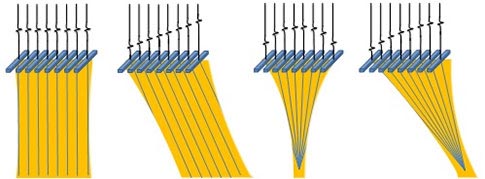Flexibility is just one of the many benefits of acquiring ultrasound data directly into a PC and then performing application-specific processing in software. However, the large number of channels in ultrasound array imaging systems introduces data throughput and front-end connectivity challenges. These can be addressed by combining channels and reducing data rate through hardware-based processing local to the digitizers. Until now, this required custom circuitry, which greatly restricted the flexibility of localized processing and defeated one of the main goals.
Conventional imaging
Steering and focusing is achieved by applying differential delays in the excitations to each ultrasonic sourcing element and in the received signals from each element. The delays compensate for the varying path lengths between the elements and the focal point to produce constructive interference at this point (figure 1).

Figure 1: Array delay controls for (from left to right): unfocused; steered; focused; steered and focused
…
Add new comment